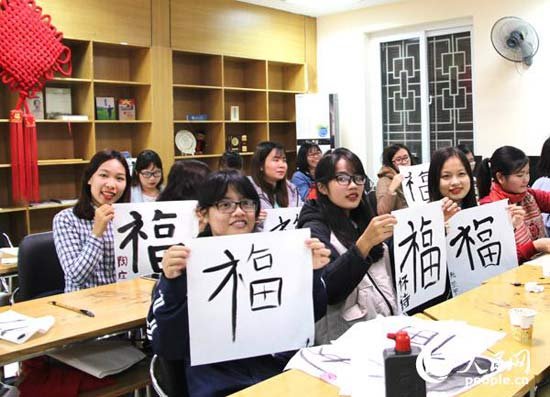
Vietnamese college students showing their first calligraphy works
On December 29th, 2017, the “Chapbooks on the Belt and Road” activity was held at the Confucius Institute at Vietnam Hanoi University by May May Lecture of China Academy of Art. Teachers and students from the academy introduced basic knowledge and techniques of Chinese painting and calligraphy to Vietnamese students, and taught them to do Chinese painting and calligraphy step by step, appreciating the beauty of Chinese culture and art together.
The Four Treasures of Study, the brush, ink, paper and ink stone are not new to Vietnamese students. The brush contains weasel hair brush, goat hair brush, doubled both Brush and chicken feather brush. Vietnamese young people showed great interest in calligraphy when Li Xiao, a graduate student from the Department Of Chinese Painting and Calligraphy of China Academy of Art, giving a more detailed introduction on the Four Treasures of Study.
Lotus is the national flower of Vietnam. Zhou Yun, a student of China Academy of Art, showed how to paint lotus starting from picture composition and then demonstrating step by step the techniques of painting the leaves, petals, and nut. In a short while, the graceful flowers created by Vietnamese students were vividly revealed on the paper.
TrầnThịthâm, a sophomore of the Chinese Department at Hanoi University never used writing brush, but she made a very good painting under the guidance of the Chinese teacher. She said to the journalist: “I didn't know the Chinese painting art before, but today I have not just widened my knowledge about it, but also drawn my first painting. It is wonderful!”
As New Year’s Day and Spring Festival are coming, people extend their best wishes to others. Chen Jinglei, a student of China Academy of Art, explained the best wishes implied in the Chinese character "Fu" to Vietnamese students, and taught them to write it with brush to welcome the New Year.
It was also the first time for NguyễnThịhoa to experience brush calligraphy. The sophomore said, “I pay all attention to the magical brush when I am practicing, and it calms me down. It is very helpful for me to learn calligraphy.”
Different from other classmates, Nguyễnthị Hảiyến, a junior student, could write beautiful hard-pen calligraphy, and also brush calligraphy. She said, “Chinese teachers’ introduction and demonstration further stimulate my interest in Chinese calligraphy and painting. I hope the Confucius Institute will hold more meaningful interchange activities like this in the future, so as to create more opportunities for Vietnamese young people.”
Lê Huyhoàng, a teacher from the Department of Foreign Languages of Hanoi Pedagogical University Number 2, has practiced calligraphy since 2006. He said: “Although I have been practicing calligraphy for many years, it’s my first time to communicate with so many Chinese painters and calligraphers face-to-face. It’s a rare chance for me and I did learn a lot.”
As the Vice President of Hanoi University and Chairman of its Confucius Institute Council, NguyễnthịCúcphương said that language and culture are inseparable from each other. It is hoped that learning painting and calligraphy could be conducive to improving students’ observation ability, aesthetic level and inspire their creative thinking.
Teachers and students of China Academy of Art gave a painting themed with landscape in Zhejiang Province to Hanoi University as a gift. On its side are seen three powerful and meaningful Chinese characters “Zhong Yue Qing” (friendship between China and Viet Nam).
Xu Luting, Director of Employment Guidance Centre of China Academy of Art, has visited Vietnam for many times. He told the journalist that Chinese painting and calligraphy are important parts and the embodiment of Chinese excellent traditional culture, carrying thousands years of Chinese humanistic spirits and philosophical thoughts. It is hoped that young people in China and Vietnam do Chinese painting and calligraphy together, so as to improve mutual understanding and friendship in a relaxed and happy atmosphere.
Teachers and students of China Academy of Art also gave Vietnamese teachers and students a series of chapbooks about Chinese excellent traditional culture. It is known that May May Lecture’s “Chapbooks on the Belt and Road” activity is committed to the dissemination and promotion of Chinese traditional culture. The activity has been successfully held and received positive responses in Sri Lanka, Indonesia, Malaysia, and Singapore.
May May Lecture is a public service activity launched by China Academy of Art in 2013, and has been held more than 100 times. Li Xiao was a keynote speaker in the first May May Lecture, and attended the activities in foreign countries. "Vietnamese youth learn how to draw lotus very quickly and their paintings are vigorous. They are able to master the techniques of drawing perfect lines,” He said, “We can feel their desire for the arts and pursuit of beauty. As a Chinese wisdom said, ‘Appreciate the values of others as do to one’s own” (cited from Confucius Institute Headquarters, source: People's Daily, Story/Photos by Liu Gang)



